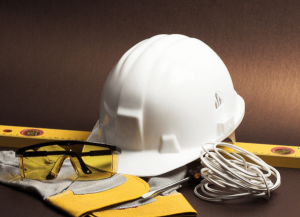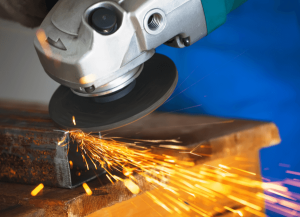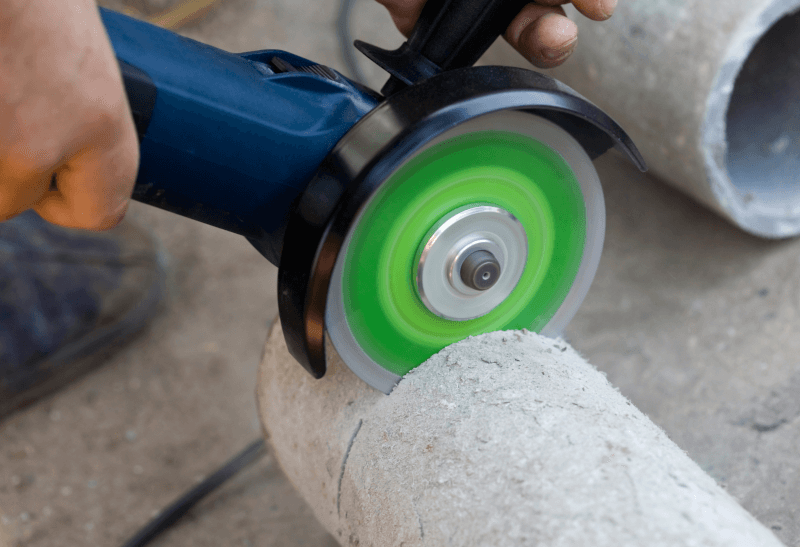Angle grinders are a great tool to have, but they do come with their own safety risks. One of these is the dust that occurs when cutting with an angle grinder. How can you stop dust from an angle grinder?
The simplest way to stop dust from an angle grinder is by using a dust shroud. This catches the dust before it moves too far away from the blade. A dust shroud can be bought or made. The other method to stop angle grinder dust using running water with the angle grinder and on the material being cut.
While we suggest the best way to stop dust from an angle grinder is with a specialised dust shroud, this isn’t the only way. Read on to find out more.
How to protect yourself against angle grinder dust
Angle grinder dust is bad for your health but seems hard to avoid when your face is positioned right above where you are grinding. This puts you in the direct path of any flying dust. The main situations you want to avoid are inhaling dust or any dust from the angle grinder getting into your eyes.
So, to protect yourself against angle grinder dust, you should wear PPE gear. A respiratory mask for construction is your best option to help protect yourself from inhaling dust. The respiratory aspect of the mask helps filter out dust particles from the air you’re breathing in. Angle grinder dust in your lungs can result in serious long-term injury if you are exposed to it for a while. To protect yourself against angle grinder dust, always wear a mask.
You also need to protect your eyes because the dust thrown up by an angle grinder can damage your eyes. This is why you should also always wear goggles when using an angle grinder. The respiratory masks are made to fit snug against your face which will prevent your safety goggles from fogging up. You might even be able to find combined goggles and masks. These two pieces of PPE are vital for protecting you and your health against angle grinder dust.
The other thing to do is lower the amount of dust produced when using an angle grinder. This can be done with a dust shroud or by using running water.
How do I make an angle grinder dust shroud?
An angle grinder dust shroud is great for catching the dust that occurs when you use an angle grinder. You can buy dust shrouds, or you can make one yourself for short-term use. Materials such as scrap plastic and duct tape can make a temporary angle grinder dust shroud. Cut a piece of plastic from a bottle or other container that can wrap around the face of your angle grinder. Attach it to the handle using tape.
Make sure you don’t obstruct the blade with the plastic. There should be an opening under the shield where the blade sits.
The other materials you can use are the inner tube of a bicycle tire and some cable ties. Wrap the tube around the face of the angle grinder and fix it in place with the cable ties. The shroud acts as a barrier to the dust, stopping it from blowing up in your face.
Both of these methods will work, but they should only be your short-term solution to stop dust from an angle grinder. If you are using your angle grinder regularly, you should invest in a proper dust shroud. This way you can be sure that it fits properly and will protect you from angle grinder dust.
Another common method for shrouding dust is with water—let’s look into that.
Can you use water to stop angle grinder dust?
The first thing to say, to preface this, is that you should always use water in tandem with other means of shrouding dust. Wear your PPE, and get some kind of dust shroud if you can.
The way to use water with an angle grinder is to wet the area you’re planning to grind. Lubricate the whole surface with water to reduce friction, first of all. Less friction will mean fewer sparks as well as less dust. The water will also keep your angle grinder blade cooler.
The water will trap the dust, stopping it from flying up into the air. Instead, the dust will become a light mud-like layer on the material and flour surrounding your working area. This can be easily cleaned up after you have finished using your angle grinder.
The effectiveness of using water to stop angle grinder dust will depend on the material you’re cutting. It’s much easier to get stone or brick wet compared to metal. Regardless, you should always lubricate the material and area that you’re cutting and grinding in some way. This will help to reduce the dust, even if it is only by a little. For materials such as stone and concrete, water is the best option for reducing dust.
How do I stop my angle grinder from sparking while reducing dust levels?
One concern when working with angle grinders is the sparks that occur. While you can reduce the dust from your angle grinder with a dust shroud, the sparking isn’t as simple. As we mentioned, using water can reduce the friction between the angle grinder blade and the material being cut. This will help reduce the sparks, but you should still be taking other precautions to protect yourself from angle grinder sparks.
The first line of defence is wearing PPE. You should have safety goggles, a respiratory mask, and safety gloves on when using an angle grinder. The goggles will protect your eyes from any sparks, and the respiratory mask will protect you from any dust in the air. The gloves will protect your hands from sparks. It’s also a good idea to wear a long-sleeved shirt to provide a layer of protection to your arms. Wear work boots and long pants. Even a safety hat is a good idea to ensure you have taken as many personal precautions as possible.
If your angle grinder is sparking excessively, even on nonmetals, there is likely to be a bigger problem. If the brushes are worn down, this can cause major sparking from your angle grinder. Remove the screws securing the brush in place and see if the bristles are even. You might, instead, find a build-up of dirt and debris. Both of these circumstances will cause excessive sparking, and sparks can be more dangerous than angle grinder dust.
With all of this being said, provided that you take safety precautions you can protect yourself against angle grinder dust and sparks.
You should always invest in a heavy-duty floor scraper to help with dust clean-up, plus a poly fibre brush for brick cleaning when working with brick. We hope this article has helped you out with your dust inhalation queries. On top of providing valuable masonry tools, Paragon Tools Ireland has plenty more useful construction information in our resources!



